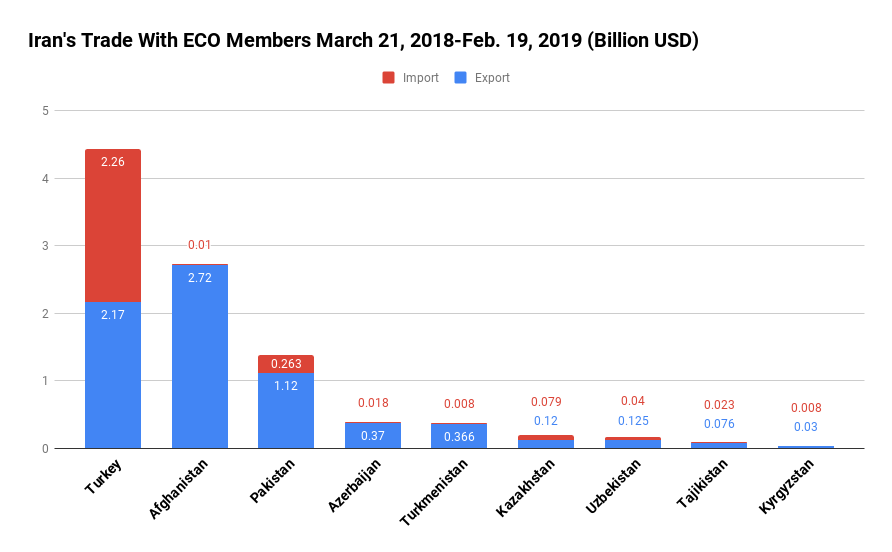Latest data released by the Islamic Republic of Iran Customs Administration show Iran traded 18.4 million tons of non-oil commodities worth $9.83 billion with ECO member states during the period to register a 0.99% and 5.01% decline in tonnage and value respectively compared with last year’s corresponding period.
Iran’s exports totaled 16.62 million tons worth $7.11 billion during the period, indicating a 2.55% and 3.59% increase in tonnage and value respectively year-on-year.
Imports stood at 1.78 million tons worth $2.71 billion, down 25.11% and 22.01% in tonnage and value respectively YOY, according to Financial Tribune.
The Economic Cooperation Organization is a Eurasian political and economic intergovernmental organization founded in 1984 in Tehran by the leaders of Iran, Pakistan and Turkey. It provides a platform to discuss ways to improve development and promote trade and investment opportunities.
An ad hoc organization under the United Nations Charter, ECO aims to establish a single market for goods and services.
ECO's secretariat and cultural department are located in Iran, its economic bureau is in Turkey and its scientific bureau is established in Pakistan. Consisting of predominantly Muslim-majority states, it is a trade bloc for Central Asian states connected to the Mediterranean through Turkey, to the Persian Gulf via Iran and to the Arabian Sea via Pakistan.
Main Commodities, Trading Partners
Iran mainly exported liquefied natural gas, low-density oils, non-alloy zinc, bitumen and iron/steel bars to ECO member states.
In exchange, major commodities imported into Iran from ECO nations included semi-milled rice, wholly-milled rice, cooking bananas, cotton and tobacco.
In terms of trade value, Turkey topped the list among ECO countries with bilateral trade with Iran standing at 7.67 million tons worth $4.43 billion, down by 12.5% and 17.04% in tonnage and value respectively YOY.

Exports to Turkey amounted to 6.52 million tons worth $2.17 billion to register a 7.63% and 9.72% growth in tonnage and value respectively YOY.
Turkey was Iran’s second biggest export destination among the countries under review and fifth among all countries.
In return, Turkey exported 1.15 million tons of commodities worth $2.26 billion to Iran, down by 32.6% and 23.04% in tonnage and value respectively YOY.
Turkey was the top exporter of goods to Iran among ECO states and third among all countries after China and the UAE.
Major Iranian commodities exported to Turkey were natural liquefied gas, non-alloy zinc, aluminum, urea and bitumen.
Turkey mainly exported cooking bananas, tobacco and fiber to Iran.
Afghanistan was Iran’s second biggest trading partner among ECO nations during the period, as two-way commercial exchanges stood at 5.24 million tons worth $2.73 billion to register a 2.4% decline in tonnage and 8.41% growth in value YOY.
Iran exported 5.23 million tons of goods worth $2.72 billion to Afghanistan, down by 2.15% in tonnage and up by 8.83% in value YOY.
Afghanistan was Iran’s top export destination among ECO states and fourth among all countries.
Iran’s exports to Afghanistan included low-density oils, iron/steel bars and floorings.
Iran imported 9,680 tons of commodities worth $10.05 million from Afghanistan, down 58.41% and 47.1% in tonnage and value respectively YOY, which mainly included herbs used for perfume making and medical purposes, sesame seeds, lead, oilseeds and fruits.
Afghanistan was the seventh exporter of goods to Iran among countries under review and 72nd exporter to Iran among all countries.
Pakistan was Iran’s third major trading partner among ECO states.
Mutual trade between Iran and Pakistan amounted to 2.73 million tons worth $1.39 billion, indicating a 19.73% and 18.19% increase in tonnage and value respectively YOY.
Iran’s exports reached 2.48 million tons worth $1.12 billion, up 27.69% and 37.82% in tonnage and value respectively YOY, while Pakistan’s exports to Iran were at 242,066 tons worth $263.93 million, down by 27.04% and 26.53% in tonnage and value respectively YOY.
Pakistan was Iran’s third export destination as well as the second exporter of goods to Iran among ECO members. The country was Iran’s eighth export destination and 23rd exporter to Iran among all countries.
Bitumen, low-density oils, liquefied propane, pod vegetables and pistachios were Iran’s main goods exported to Pakistan, while Pakistan exported mainly semi-milled rice, wholly-milled rice, sesame seeds, cans, pears and beef.
Kazakhstan was the third biggest exporter to Iran, after Turkey and Pakistan, among ECO countries and 35th among all countries, as Iran imported 268,719 tons worth $79.23 million from Kazakhstan during the period, up by 55.44% and 49.67% in tonnage and value respectively YOY.
Iran mainly imported barley, sheep carcasses and colza seeds from Kazakhstan.
Highest Growths, Declines in Trade
Trade with Azerbaijan (at $89.33 million), Pakistan ($1.39 billion) and Uzbekistan ($166.29 million) saw the highest YOY growth of 29.66%, 18.19% and 11.8% respectively, while trade with Tajikistan ($100.07 million), Turkey ($4.43 billion) and Turkmenistan ($374.38 million) witnessed the lowest decline of 53.78%, 17.04% and 6.06% respectively.
Iran’s exports to Uzbekistan ($125.65 million), Pakistan ($1.12 billion) and Azerbaijan ($370.7 million) saw the highest growth of 40.09%, 37.82% and 33.34% respectively, while exports to Tajikistan ($62.55 million), Kazakhstan ($120.82 million) and Kyrgyzstan ($30.12 million) witnessed the highest decline of 62.55%, 18.04% and 11.26% respectively.
Imports from Tajikistan ($23.62 million), Kyrgyzstan ($8.61 million) and Kazakhstan ($79.23 million) saw the highest growth of 90.28%, 68.38% and 49.67% respectively while imports from Afghanistan ($10.05 million), Uzbekistan ($40.63 million) and Turkmenistan ($8.08 million) witnessed the highest decline of 47.1%, 31.18% and 30.87% respectively.


